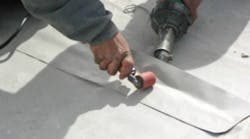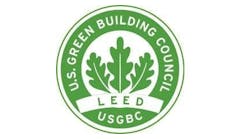Low-slope roof systems rarely live out their intended lifetime without some attention. In most cases, abuse by other trades caises penetrations that, at such low slopes, result in leakage and harm to the underlying thermal insulation and roof deck. This column will address one generic category of roof systems, thermoplastic roof membrane systems. Of all our membrane types, the thermoplastic systems are usually the thinnest, ranging from 30 to 60 mils on the thin side but can be purchased up to 90 mils thick.
Repair Materials
Professional knowledge and appropriate tools are needed to bring the membrane back to a leak-free condition. You may conclude that having the original roof installer come back to plug every hole is the best option, but you will quickly discover that roof warranties exclude leaks due to abuse.
Puncture repairs using bituminous materials have been around for more than a century and can be installed by torch, mastic or even self-adhesion. Thermoset materials include rubber such as EPDM and are patched with peel and stick tapes or solvent-based adhesive.
Thermoplastic materials are different, however. They include PVC, CPE, CSPE, TPO and KEE. Members of this class are usually heat-welded as they are incompatible with bituminous substances. (Some of the older existing membranes may also be solvent-welded.)
Patch a Membrane in 7 Steps
Ready to fix your damaged membrane? The joint NRCA, SPRI and ARMA publication Repair Manual for Low-Slope Membrane Roof Systems recommends the following patch procedure. Pick up your own copy of this useful resource through the National Roofing Contractors Association.
Richard (Dick) L. Fricklas, received a Lifetime Achievement Award and fellowship from RCI in 2014 in recognition of his contributions to educating three generations of roofing professionals. A researcher, author, journalist, and educator, Fricklas retired as technical director emeritus of the Roofing Industry Educational Institute in 1996. He is co-author of The Manual of Low Slope Roofing Systems (now in its fourth edition) and taught roofing seminars at the University of Wisconsin, in addition to helping develop RCI curricula. His honors include the Outstanding Educator Award from RCI, William C. Cullen Award and Walter C. Voss Award from ASTM, the J. A. Piper Award from NRCA, and the James Q. McCawley Award from the MRCA. Dick holds honorary memberships in both ASTM and RCI Inc.
- Prepare the surfaces.
- Scrub the repair area.
- Rinse, squeegee, or wipe with clean rag.
- If the surface of the existing membrane is badly oxidized, it may be possible to enlarge the hole, insert the new patch underneath and heat weld to the bottom side of the membrane.
- Heat weld the patch in place.
- Probe the exposed edges.
- Use caulking at perimeter of the patch if the membrane scrim appears to wick water.
Note that the repair requires a heat-welder, an appropriate source of voltage, and a silicone roller to ensure good contact. The heat-welder may generate temperatures as high as 800 degrees F., so caution is advised. Precautions include a minimum of two workers to get the generator up where it is needed. It may be best to find, elevate, and plug the holes with duct tape until the area is dry and permanent repairs can be made.
How Cool Roofs Stack Up
A comparison of white roof membranes.
Avoid Roofing Condensation Issues
Beware: these situations can lead to costly repairs.
Maximize Roof Service Life
Raise the ceiling on your roof’s value.


